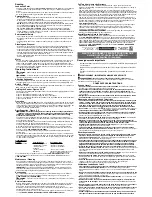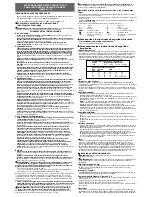
General Safety Rules
WARNING: Read and understand all instructions.
Failure to follow all instructions listed
below may result in electric shock, fire and/or serious personal injury.
SAVE THESE INSTRUCTIONS
Work Area
•
Keep your work area clean and well lit.
Cluttered benches and dark areas invite
accidents.
•
Do not operate power tools in explosive atmospheres, such as in the presence of
flammable liquids, gases, or dust.
Power tools create sparks which may ignite the dust
or fumes.
•
Keep bystanders, children, and visitors away while operating a power tool.
Distractions can cause you to lose control.
Electrical Safety
•
Double insulated tools are equipped with a polarized plug (one blade is wider than
the other). This plug will fit in a polarized outlet only one way. If the plug does not fit
fully in the outlet, reverse the plug. If it still does not fit, contact a qualified
electrician to install a polarized outlet. Do not change the plug in any way
. Double
insulation
eliminates the need for the three wire grounded power cord and grounded
power supply system.
•
Avoid body contact with grounded surfaces such as pipes, radiators, ranges and
refrigerators.
There is an increased risk of electric shock if your body is grounded.
•
Don’t expose power tools to rain or wet conditions.
Water entering a power tool will
increase the risk of electric shock.
•
Do not abuse the cord. Never use the cord to carry the tools or pull the plug from an
outlet. Keep cord away from heat, oil, sharp edges or moving parts. Replace
damaged cords immediately.
Damaged cords increase the risk of electric shock.
•
When operating a power tool outside, use an outdoor extension cord marked "W-A"
or "W".
These cords are rated for outdoor use and reduce the risk of electric shock.
Personal Safety
•
Stay alert, watch what you are doing and use common sense when operating a
power tool. Do not use tool while tired or under the influence of drugs, alcohol, or
medication.
A moment of inattention while operating power tools may result in serious
personal injury.
•
Dress properly. Do not wear loose clothing or jewelry. Contain long hair. Keep your
hair, clothing, and gloves away from moving parts.
Loose clothing, jewelry, or long hair
can be caught in moving parts. Air vents may cover moving parts and should be avoided.
•
Avoid accidental starting. Be sure switch is off before plugging in.
Carrying tools with
your finger on the switch or plugging in tools that have the switch on invites accidents.
•
Remove adjusting keys or wrenches before turning the tool on.
A wrench or key that is
left attached to a rotating part of the tool may result in personal injury.
•
Do not overreach. Keep proper footing and balance at all times.
Proper footing and
balance enables better control of the tool in unexpected situations.
•
Use safety equipment. Always wear eye protection.
Dust mask, non-skid safety shoes,
hard hat, or hearing protection must be used for appropriate conditions.
Tool Use and Care
•
Use clamps or other practical way to secure and support the workpiece to a stable
platform.
Holding the work by hand or against your body is unstable and may lead to loss
of control.
•
Do not force tool. Use the correct tool for your application.
The correct tool will do the
job better and safer at the rate for which it is designed.
•
Do not use tool if switch does not turn it on or off.
Any tool that cannot be controlled
with the switch is dangerous and must be repaired.
•
Disconnect the plug from the power source before making any adjustments,
changing accessories, or storing the tool.
Such preventative safety measures reduce
the risk of starting the tool accidentally.
•
Store idle tools out of reach of children and other untrained persons.
Tools are
dangerous in the hands of untrained users.
•
Maintain tools with care. Keep cutting tools sharp and clean.
Properly maintained
tools, with sharp cutting edges are less likely to bind and are easier to control.
•
Check for misalignment or binding of moving parts, breakage of parts, and any other
condition that may affect the tools operation. If damaged, have the tool serviced
before using.
Many accidents are caused by poorly maintained tools.
•
Use only accessories that are recommended by the manufacturer for your model.
Accessories that may be suitable for one tool, may become hazardous when used on
another tool.
Service
•
Tool service must be performed only by qualified repair personnel.
Service or
maintenance performed by unqualified personnel could result in a risk of injury.
•
When servicing a tool, use only identical replacement parts. Follow instructions in
the Maintenance section of this manual.
Use of unauthorized parts or failure to follow
Maintenance Instructions may create a risk of electric shock or injury.
WARNING: Some dust created by power sanding, sawing, grinding, drilling, and
other construction activities contains chemicals known to cause cancer, birth defects
or other reproductive harm. Some examples of these chemicals are:
• lead from lead-based paints,
• crystalline silica from bricks and cement and other masonry products, and
• arsenic and chromium from chemically-treated lumber (CCA).
Your risk from these exposures varies, depending on how often you do this type of work. To
reduce your exposure to these chemicals: work in a well ventilated area, and work with
approved safety equipment, such as those dust masks that are specially designed to filter out
microscopic particles.
•
Avoid prolonged contact with dust from power sanding, sawing, grinding, drilling, and
other construction activities. Wear protective clothing and wash exposed areas with
soap and water.
Allowing dust to get into your mouth, eyes, or lay on the skin may promote
absorption of harmful chemicals.
WARNING: Use of this tool can generate and/or disburse dust, which may cause
serious and permanent respiratory or other injury.
Always use NIOSH/OSHA approved
respiratory protection appropriate for the dust exposure. Direct particles away from face and
body.
CAUTION: Wear appropriate hearing protection during use.
Under some conditions
and duration of use, noise from this product may contribute to hearing loss.
First Aid Measures for Gel Components
If gel within the comfort grip becomes exposed and results in skin contact wash with soap
and water; For eye contact, flush with flowing water. If swallowed, seek medical attention.
Material Safety Data Sheet (MSDS) available from
1-800-544-6986
The label on your tool may include the following symbols.
V ..........................volts
A..........................amperes
Hz ........................hertz
W ........................watts
min ........................minutes
......................alternating current
......................direct current
no ........................no load speed
..........................Class II Construction
........................earthing terminal
........................safety alert symbol
.../min ..................revolutions or
reciprocations
per minute
Cat. No. FS3000ROS
Form No. 492310-00
Copyright © 2005 Black & Decker
Printed in China (DEC. ‘05)
KEY INFORMATION YOU SHOULD
KNOW:
• Never operate the sander without
recommended sandpaper properly installed
on the base.
• Do not push down—let the sander do the
work.
• Extended drywall sanding is not
recommended.
VEA EL ESPAÑOL EN LA CONTRAPORTADA.
SAVE THIS MANUAL FOR FUTURE REFERENCE.
INSTRUCTIVO DE OPERACIÓN, CENTROS DE SERVICIO Y
PÓLIZA DE GARANTÍA.
ADVERTENCIA:
LÉASE ESTE
INSTRUCTIVO ANTES DE USAR EL PRODUCTO.
INSTRUCTION MANUAL
R
R
R
R
a
a
a
a
n
n
n
n
d
d
d
d
o
o
o
o
m
m
m
m
O
O
O
O
rr
rr
b
b
b
b
ii
ii
tt
tt
S
S
S
S
a
a
a
a
n
n
n
n
d
d
d
d
e
e
e
e
rr
rr
Safety Warnings and Instructions: Sanders
•
ALWAYS WEAR EYE AND RESPIRATORY PROTECTION.
• Clean your tool out periodically.
Other Important Safety Warnings and Instructions
Extension Cords
When using an extension cord, be sure to use one heavy enough to carry the current your
product will draw. An undersized cord will cause a drop in line voltage resulting in loss of
power and overheating. The following table shows the correct size to use depending on cord
length and nameplate ampere rating. If in doubt, use the next heavier gage. The smaller the
gage number, the heavier the cord.
1
B E F O R E R E T U R N I N G T H I S P R O D U C T
F O R A N Y R E A S O N P L E A S E C A L L
1 - 8 0 0 - 5 4 4 - 6 9 8 6
IF YOU SHOULD HAVE A QUESTION OR
EXPERIENCE A PROBLEM WITH YOUR
BLACK & DECKER PRODUCT,
C A L L 1 - 8 0 0 - 5 4 4 - 6 9 8 6
BEFORE YOU CALL, HAVE THE FOLLOWING INFORMATION AVAILABLE, CATALOG No., TYPE
No., AND DATE CODE (e.g. 0130M). IN MOST CASES, A
BLACK & DECKER
REPRESENTATIVE
CAN RESOLVE YOUR PROBLEM OVER THE PHONE. IF YOU HAVE A SUGGESTION OR
COMMENT, GIVE US A CALL. YOUR FEEDBACK IS VITAL TO BLACK & DECKER.
2
Catalog No. FS3000ROS
3
4
6
5
Minimum Gage for Cord Sets
Volts
Total Length of Cord in Feet
120V
0-25
26-50
51-100
101-150
240V
0-50
51-100 101-200
201-300
Ampere Rating
More
Not more
American Wire Gage
Than
Than
0
-
6
18
16
16
14
6
-
10
18
16
14
12
10 -
12
16
16
14
12
12 -
16
14
12
Not Recommended





